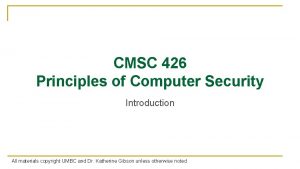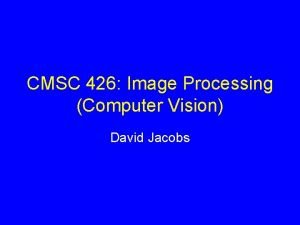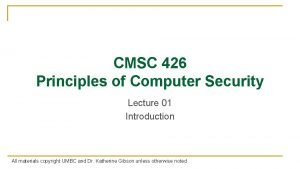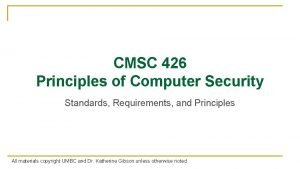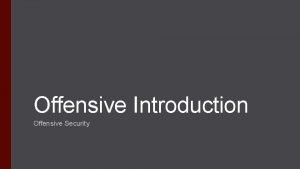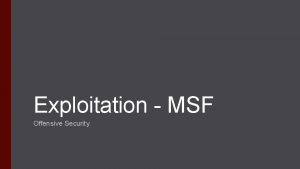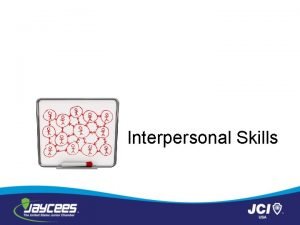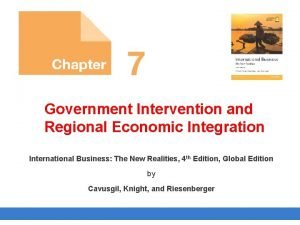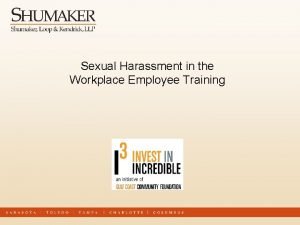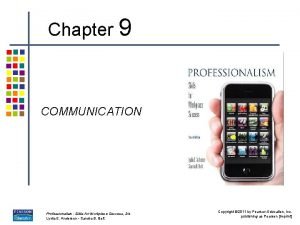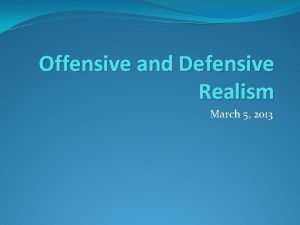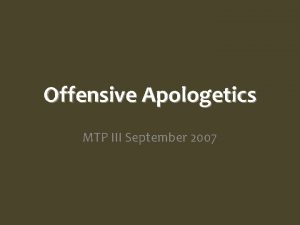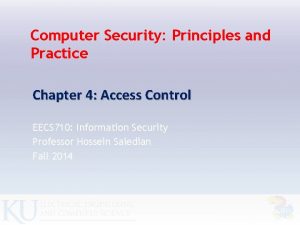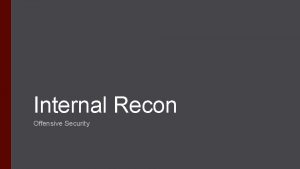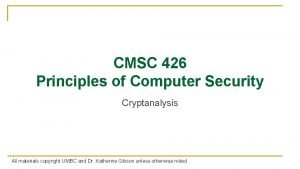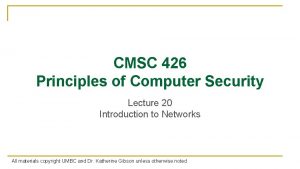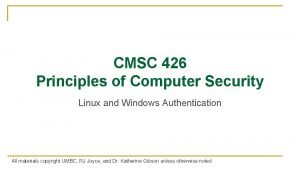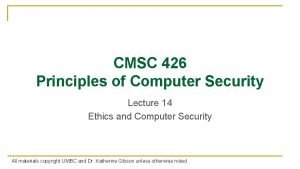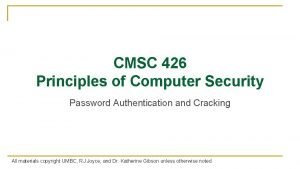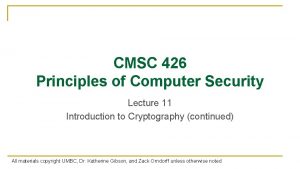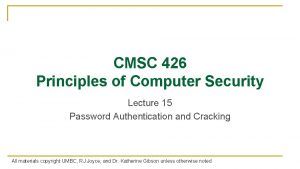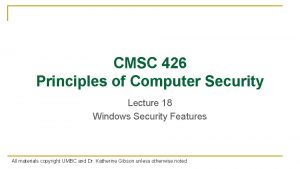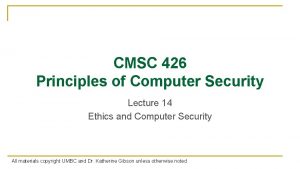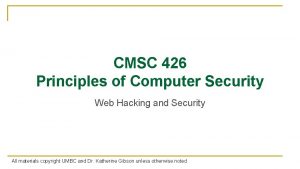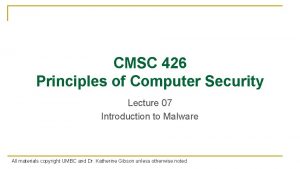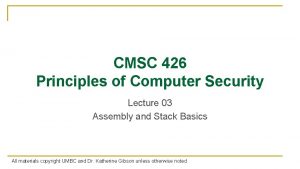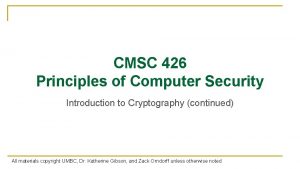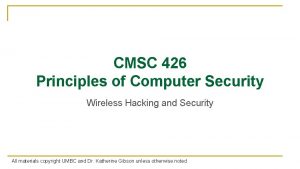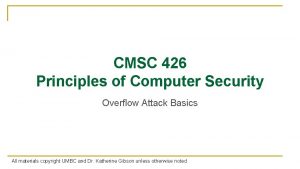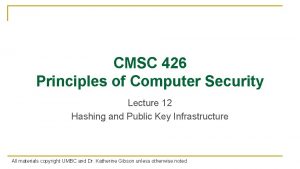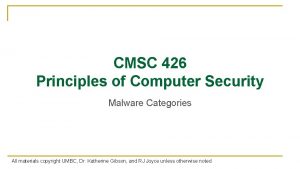CMSC 426 Principles of Computer Security Offensive Security





























- Slides: 29

CMSC 426 Principles of Computer Security Offensive Security and Hardening All materials copyright UMBC, Kevin Bilzer, Seamus Burke and Dr. Gibson unless otherwise noted

Last Class We Covered § Hardening § Windows hardening methods q q Defender Automatic updates Security policy Group policy All materials copyright UMBC, Kevin Bilzer, Seamus Burke and Dr. Gibson unless otherwise noted 2

Any Questions from Last Time? All materials copyright UMBC, Kevin Bilzer, Seamus Burke and Dr. Gibson unless otherwise noted 3

Today’s Topics § Offensive security q q q What it is Attacker Lifecycle Common tools § Demo § Effective Windows Hardening All materials copyright UMBC, Kevin Bilzer, Seamus Burke and Dr. Gibson unless otherwise noted 4

Offensive Security All materials copyright UMBC, Kevin Bilzer, Seamus Burke and Dr. Gibson unless otherwise noted 5

What is Offensive Security? § Subset of the security field q Focuses on assessing the security of machines or networks by attempting to attack them § Goal is to be proactive rather than reactive q q We’ve previously talked about figuring out who launched an attack, or tracing them back to their source Much easier to prevent it in the first place § The best defense is a good offense! All materials copyright UMBC, Kevin Bilzer, Seamus Burke and Dr. Gibson unless otherwise noted 6

Attacker Lifecycle Most important part – without recon (and enumeration), success is unlikely All materials copyright UMBC, Kevin Bilzer, Seamus Burke and Dr. Gibson unless otherwise noted 7

1: Reconnaissance § “Knowing your target” § Involves gathering information about the target q Can often be collected without the target detecting it § Technical information q Network information from scanning, etc. Port scanning All materials copyright UMBC, Kevin Bilzer, Seamus Burke and Dr. Gibson unless otherwise noted 8

1: Reconnaissance (continued) § Business information q OSINT (Open Source INTelligence) § Going to a company’s website, github, trello board, etc. § Information about employees, positions, technology they use § Real examples: passwords in code comments, keys committed to github § Goal is to get information you can use to get in All materials copyright UMBC, Kevin Bilzer, Seamus Burke and Dr. Gibson unless otherwise noted 9

1. 5: Enumeration § Goal in this stage is to identify exactly what versions of which services are running § Look for known exploits and vulnerabilities for those specific versions § Are there common misconfigurations which show up a lot with these specific technologies? § How do you test for these misconfigurations? All materials copyright UMBC, Kevin Bilzer, Seamus Burke and Dr. Gibson unless otherwise noted 10

2: Compromise § Actually breaking into machines, often what people think about when they think of “hacking” q Not actually that exciting though § It only takes one weak link to own an enterprise q q Phishing emails, infected document downloads Why client-side exploits are still a thing All materials copyright UMBC, Kevin Bilzer, Seamus Burke and Dr. Gibson unless otherwise noted 11

3: Persistence § After you initially gain access into a network, you want to make sure you can always get back in § This doesn’t just mean in 5 minutes, it means days, weeks, or months later § Ideally even after reboots, resets, etc. All materials copyright UMBC, Kevin Bilzer, Seamus Burke and Dr. Gibson unless otherwise noted 12

3: Post Exploitation § This is what separates the skilled attackers from everyone else § What can you do with your access? q q q Can you escalate privileges on your local machine? What is accessible within the network? Can you get access to file servers, internal source code, documents? Can you get access to other users’ machines? Can you elevate your privileges on a network level? § To Domain Administrator? q How easy is it to stay undetected? All materials copyright UMBC, Kevin Bilzer, Seamus Burke and Dr. Gibson unless otherwise noted 13

Tools and Attacks All materials copyright UMBC, Kevin Bilzer, Seamus Burke and Dr. Gibson unless otherwise noted 14

Metasploit § Open source attack framework, written in Ruby q q Can be used to write and launch own exploits Managing different sessions Escalating privileges Covers basically everything you would need § Very much a “point-and-click tool” All materials copyright UMBC, Kevin Bilzer, Seamus Burke and Dr. Gibson unless otherwise noted 15

Using Metasploit § Walks you through the major steps in launching an attack q q q Choosing and setting up an exploit Checking to see if the target is vulnerable Choosing and configuring a payload Choosing the encoding and evasion techniques for the payload Launching the attack Handling the connections § This one is particularly useful All materials copyright UMBC, Kevin Bilzer, Seamus Burke and Dr. Gibson unless otherwise noted 16

Recap: LSA and LSASS § LSA (Local Security Authority) q Windows subsystem responsible for managing authentication and local security policy § LSASS (LSA Subsystem Service) q q The process in which LSA runs Responsible for providing single sign-on functionality in Windows § Does this by caching credentials in memory. Why is this bad? All materials copyright UMBC, Kevin Bilzer, Seamus Burke and Dr. Gibson unless otherwise noted 17

Mimikatz § Tool which can dump Windows passwords (and other things) from the memory q For every user who logged in since the last boot § (This should scare you) All materials copyright UMBC, Kevin Bilzer, Seamus Burke and Dr. Gibson unless otherwise noted 18

“Passing” Attacks All materials copyright UMBC, Kevin Bilzer, Seamus Burke and Dr. Gibson unless otherwise noted 19

“Passing” Attacks § Pass the Hash and Pass the Ticket § Goal of both attacks is to impersonate another user q q Pass the Hash: specifically, password hashes Pass the Ticket: Kerberos tickets § Allows attacker to q q Gain access to new info and systems Hide their tracks (and prevent discovery) All materials copyright UMBC, Kevin Bilzer, Seamus Burke and Dr. Gibson unless otherwise noted 20

How a Pass the Hash Attack Works § Using a stolen password hash in place of the actual password q (e. g. , obtained through Mimikatz) § Want to authenticate as a user without having access to their plaintext password(s) q q Fortunately, NTLM hashes are often just as good as passwords Lots of Windows functions will accept a hash in place of a password § Newer systems store just the hash in memory q Older systems store both the hash and the plaintext (yay? ) All materials copyright UMBC, Kevin Bilzer, Seamus Burke and Dr. Gibson unless otherwise noted 21

Exploiting a Pass the Hash Attack § Can now be used for lateral movement or spawning processes q q Connecting to other systems using that same user account/password Launching processes under another account name § Launching has two benefits: q q The launching of the application/process cannot be easily traced back to the person who actually launched it, just the username who did so Other users may have more privileges All materials copyright UMBC, Kevin Bilzer, Seamus Burke and Dr. Gibson unless otherwise noted 22

How a Pass the Ticket Attack Works § Hacker validates themselves as a specific user by presenting a Kerberos ticket (TGT or SGT) to the system § Grab another user’s cached Kerberos ticket (still valid) q q Use that ticket as your own, with that user’s privileges Kerberos makes use of NTLM hashes on Windows machines § Why does this work? Doesn’t Kerberos verify ticket validity? q There’s a 20 -minute window after creation where this doesn’t happen All materials copyright UMBC, Kevin Bilzer, Seamus Burke and Dr. Gibson unless otherwise noted 23

Three Types of Tickets § Regular Ticket q q Intercepted tickets meant for another user May have higher privileges than attacker does § “Silver” Tickets (Service-Granting Ticket) q q Forged ticket for specific services Lets the attacker “write their own” ticket for that specific service § “Golden” Tickets (Ticket-Granting Ticket) q q Forged ticket for essentially anything Lets the attacker “write their own” ticket for anything All materials copyright UMBC, Kevin Bilzer, Seamus Burke and Dr. Gibson unless otherwise noted 24

“Fancy” Tickets § Silver tickets q Requires the Service Account password hash § Golden tickets q q Requires the KRBTGT (Kerberos TGT) password hash Allows the attacker to sort of “impersonate” the AS § Means they can write a ticket for any service on any machine for any user § Including users that don’t exist in the system § Only way to remove a golden ticket’s effectiveness q Change password twice (keeps old password for older tickets) All materials copyright UMBC, Kevin Bilzer, Seamus Burke and Dr. Gibson unless otherwise noted 25

DEMO TIME!!! All materials copyright UMBC, Kevin Bilzer, Seamus Burke and Dr. Gibson unless otherwise noted 26

Windows Hardening All materials copyright UMBC, Kevin Bilzer, Seamus Burke and Dr. Gibson unless otherwise noted 27

General Hardening Tips § § Patch! Remove or disable unnecessary services Good account and password practices Good firewall practices q Your current Windows defaults are NOT good enough All materials copyright UMBC, Kevin Bilzer, Seamus Burke and Dr. Gibson unless otherwise noted 28

Mimikatz-Specific Defense § Disable cleartext passwords in memory q q q Apply corresponding patch and edit corresponding registry key HKEY_LOCAL_MACHINE/SYSTEM/Current. Control. Set/Control/Secur ity. Providers/WDigest/Use. Logon. Credential Default in Windows 8. 1 and later § Good account and password practices All materials copyright UMBC, Kevin Bilzer, Seamus Burke and Dr. Gibson unless otherwise noted 29
 Cmsc 426 umbc
Cmsc 426 umbc Cmsc 426 umd
Cmsc 426 umd Umbc cmsc 426
Umbc cmsc 426 Cmsc 426
Cmsc 426 Intro to offensive security
Intro to offensive security Offensive security metasploit
Offensive security metasploit In the restroom tishena was brushing her hair
In the restroom tishena was brushing her hair Being zealous without being offensive means---
Being zealous without being offensive means--- Offensive line everyday drills
Offensive line everyday drills Chapter 3 lesson 3 expressing emotions in healthful ways
Chapter 3 lesson 3 expressing emotions in healthful ways Types of offensive strokes in table tennis
Types of offensive strokes in table tennis Penguins elbow name
Penguins elbow name Offensive rationale for government intervention
Offensive rationale for government intervention Backspin counterpart to the offensive loop drive
Backspin counterpart to the offensive loop drive Mary likes hiking swimming and to ride a bicycle
Mary likes hiking swimming and to ride a bicycle Offensive language in the workplace
Offensive language in the workplace Offensive language in the workplace
Offensive language in the workplace Professionalism skills for workplace success
Professionalism skills for workplace success The tet offensive
The tet offensive Defensive realism definition
Defensive realism definition Parallelism examples
Parallelism examples What is defensive realism
What is defensive realism The least offensive play in the whole darn world
The least offensive play in the whole darn world A blue ocean type of offensive strategy
A blue ocean type of offensive strategy Offensive apologetics
Offensive apologetics Chapter 30 apush
Chapter 30 apush Computer security principles and practice 4th edition
Computer security principles and practice 4th edition Computer security principles and practice solutions
Computer security principles and practice solutions Computer security principles and practice 4th edition
Computer security principles and practice 4th edition Principles of computer security
Principles of computer security
